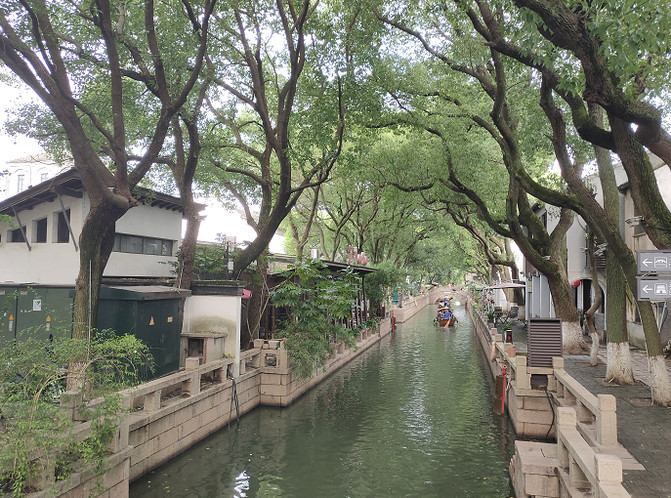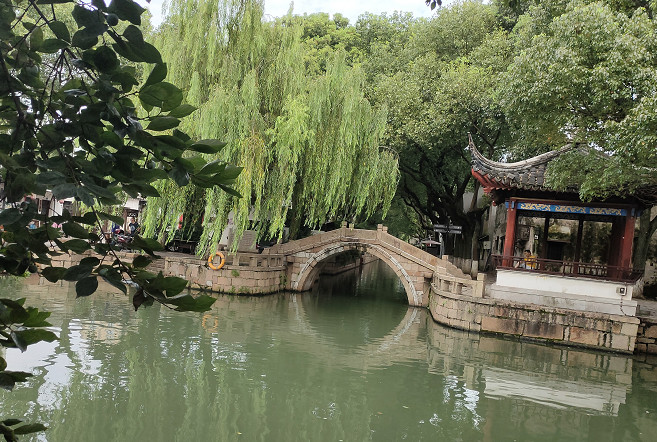Tongli Ancient Town, checking for leaks and filling gaps on bluestone slabs-Wujiang 5 (15)
★ Tourist location: Tongli Ancient Town, Wujiang, Suzhou
Although I only visited the ancient town three months ago, it is one of the most famous attractions closest to the hotel, so I always have to come and check out. Although new friends don't like to travel, they can't bear to give up the attractions that are close to them. So the two of them met to travel together, and because we were afraid that the parking lot would be full, we chose to travel by public transport. It is not far from the hotel to the ancient town. In just a few stops, I saw the archway of Tongli Ancient Town. The place where we got off was in the north of the town. In fact, there were still a lot of empty spaces in the parking lot here. I was just surprised by the full parking on the roadside during holidays.

There are many scenic spots in Tongli Ancient Town. The more famous ones are Tuisi Garden, Jiayintang, Pearl Tower Jingyuan, and Chongbentang. They are basically concentrated. Geng Le Hall and Chen Qubing's former residence are slightly far away, so these two scenic spots are easy to be ignored. In fact, the essence of Tongli's attractions, including the dock of hand-cranked wooden boats, are also here. I came here specially to "check for leaks and fill in gaps" this time, so I didn't revisit Tuisi Garden. After all, I had visited Tuisi Garden before this season, and there was not much time to plan, so I easily decided to give up Tuisi Garden and Mingqing Street, come out of Chen Qubing's former residence, and enter the central area of the ancient town from Songbei Highway.

Moving north along the river, there are not many tourists in this area, and some strange things have also been built along the river... pavilions have been built along the river, facing Chen Qubing's former residence east and west across the river. Opposite it from north to south is Nanyuan Tea House. This pavilion is connected to a long corridor, where several elderly people are resting and chatting. They do not seem to be tourists and speak a soft Wunong language.

Nanshe Pavilion looks very simple, with vermilion pillars and eaves, but the top of the pavilion is covered with black tiles. Nanshe Pavilion is of course a memorial to Nanshe, but it is very simple. Only the four corners of the pillars can be used for tourists to rest, and there is also a bicycle parked in the pavilion...

Entering Nandai from Renmin Bridge, the scenery on the bridge is better. Against the background of blue sky and white clouds, there are people living on the river with small bridges and flowing water. This is also the intersection of two rivers. The houses with white walls and black tiles look very quiet and beautiful against the backdrop of lush trees and high forests. Occasionally, there is a small boat leisurely, as if you hear the melodious tune of Wu Ge.

The bluestone street is not wide. There are long stone strips in the middle, and long stone slabs are paved lengthwise on both sides. The stones on both sides are a little broken. After all, after a century of wind and frost, time will always leave some mottled traces. Most of the houses are two-story buildings, and the walls also look old, and the lower half is mostly covered with moss.

Chuanxin Lane is a particularly narrow lane that can only accommodate one person. If someone comes across, you have to stand sideways and stop slightly to let the other person pass. Of course, the other party also needs to slow down and pass sideways. The so-called heart-piercing, I wonder if it is because the two people who meet each other must have their hearts to their hearts for a moment, so it is called heart-piercing? Of course, maybe there is a sad and beautiful love story here, so heartbreaking will not be a happy ending.

The entire piercing through the heart is 300 meters long, with a bit wider at both ends and a bit narrower in the middle. It is estimated that the place where the "piercing through" passes is here. It is said that there is hollow under the stone slab, and the upper alley is also called "castanboard lane". I think this place should be more suitable for clogs. Listening to the crisp sound is the correct way to walk in Chuanxin Lane. If there is light rain in the sky and if there is a girl in purple, it will have the artistic conception of a Jiangnan water town. Through the heart, whose heart is it wearing?

Walking forward leads to the Geng Le Hall, but I chose to turn around to find the Catholic Church I saw on the map of Gaode. Although the Christian Church just now disappointed me and I didn't have much hope for the Catholic Church based on my two experiences in Tongli, I still wanted to get a card. Probably this wasn't much of an attraction, so there was no sign on the road sign. I followed Gao De's voice prompts all the way, but I still accidentally passed it. When I went back, I saw a small door face with the words "Catholic Church" written on it. The black lacquer door was closed, which was really too inconspicuous.

Small bridges and flowing water are an indispensable combination of ancient towns in Jiangnan. Willow trees are clustered around, the arch bridge is reflected, and occasionally small boats shuttle through the bridge holes. This is a beautiful dynamic picture of the town.

While walking, I searched for the map, and I saw Pang's Ancestral Hall again, so I followed the map's voice all the way forward, and then passed the familiar Taihu Water Conservancy Exhibition Hall and Songshiwu Garden. The map showed that I had to cross the Pearl Tower Scenic Garden. No wonder the map also knows that I have an annual card and don't have to worry about ticket purchases?

Since you are here, let's go in. I still have a soft spot for the garden in the familiar scene. The garden and the main building are separated by a river. At this time, of course, I understood why the navigation insisted on letting me enter the scenic spot, because the destination I set was originally someone else's ancestral hall! If you don't enter the scenic spot, you can't get around it...

The garden is still the same as it used to be, except that only green green leaves are left in the hydrangea bush. The untied boat is the core of the entire garden. Although the terrain is not high, you can see the scenic spots along the lake by leaning on the boat.

This time, we didn't have to go back to the gate. The side door of the archway finally opened. It shows that we have won the battle against the COVID-19 epidemic. When I go out, the river is still clear and the streets and alleys are narrow. It was getting late. After walking along the Tongli Canal for a while, although there might be one or two scenic spots ahead, it was time to close the door and say goodbye to guests.

The big trees by the Pu 'an Bridge are lush with branches and leaves, and the steps are densely covered with green radishes. Although I was sweating all the way, it seemed to feel cooler when I walked here.

Crossing the bridge and leaving the ancient town, walking to the bus stop and returning home, ending another trip to Tongli. Every time I visit the ancient town, I always seem to find some places that were once ignored. For example, the Tongli Canal that runs through the ancient town, such as those small attractions that take a long time to find, such as the antique streets and alleys, there are always one or two that have not been walked through...









Previous Article:Jiangnan culture, intoxicating gardens encounter dense Baiyun Mountain, Suzhou gardens amaze Yangcheng
Next Article:100 yuan for a day: During the long May Day holiday, I took my daughter to visit Suzhou City
